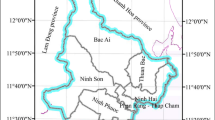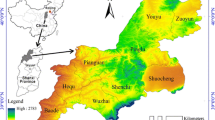Abstract
Sensitivity assessment is useful for monitoring land desertification. Research into how to prevent and control desertification is also important. In the arid region of northwest China, desertification is becoming worse and is a serious problem that affects local sustainable development. Based on remote-sensing and geographic information system technology, this study establishes a “soil-terrain-hydrology-climate-vegetation” desertification sensitivity comprehensive evaluation system to reflect the spatiotemporal changes of land desertification, and proposes a spatial distance model to calculate a desertification sensitivity index. The spatiotemporal change characteristics of land desertification sensitivity in northwest China are quantitatively assessed from 2000 to 2017. Moreover, the main driving factors are analyzed using the geographical detector method. The results show the following. (1) Terrain, soil, climate, vegetation and hydrology affect and restrict each other, and constitute the background conditions of the distributions and changes of sensitivity to desertification in northwest China. (2) Desertification sensitivity generally displays a low distribution characteristic on the periphery of the area and a high one in the interior. The low-sensitivity regions are mainly in the five major mountain ranges (Altai Mountains, Tianshan Mountains, Kunlun Mountains, Altun Mountains and Qilian Mountains), while the high-sensitivity regions are mainly in regions such as the Junggar Basin, the Tarim Basin and the Inner Mongolia Plateau, as well as the Taklimakan Desert, Badain Jaran Desert and Tengger Desert. The spatial distribution of desertification sensitivity is obviously regional, and the high- and low-sensitivity regions have clear boundaries and a concentrated distribution. (3) With regard to spatiotemporal evolution, changes in desertification sensitivity since 2000 have been predominantly stable, and the overall sensitivity has displayed a slowly decreasing trend, indicating that potential desertification regions are decreasing annually and that some achievements have been made in the control of regional desertification. (4) Soil and climate play a direct role in the driving factors of desertification in northwest China, and these have been found to be the most important influential factors. Vegetation is the most active and basic factor in changing the sensitivity. In addition, topography and hydrology play a role in restricting desertification changes. Socio-economic factors are the most rapid factors affecting regional desertification sensitivity, and their impacts tend to be gradually increasing. In general, desertification has been effectively controlled in northwest China, and positive results have been achieved in such control. However, against the backdrop of intensified global climate change, increasingly prominent human activities and new normals of socio-economic development, the monitoring, assessment and control of desertification in China still have a long way to go.
Similar content being viewed by others
References
Amani M, Salehi B, Mahdavi S et al., 2017. Temperature-Vegetation-soil Moisture Dryness Index (TVMDI). Remote Sensing of Environment, 197: 1–14.
Ahmed A, Nawaz R, Woulds C et al., 2020. Influence of hydro-climatic factors on future coastal land susceptibility to erosion in Bangladesh: A geospatial modelling approach. Journal of Geovisualization and Spatial Analysis, 4(1): 1–24.
Bi J X, Zhen J, Wang Y J et al., 2017. The method of enhanced Gaussian function weighted KNN indoor positioning. Bulletin of Surveying and Mapping, 6: 9–12.
Cristina N M, Valeria A M, 2017. Assessing the progress of desertification of the southern edge of Chihuahua Desert: A case study of San Luis Potosi Plateau. Journal of Geographical Sciences, 27(4): 420–438.
Cui B L, Li X Y, Jiang G H et al., 2011. Study on land use/cover in mountain area based on the DEM: Taking the Qinghai Lake Basin as an example. Journal of Natural Resources, 26(5): 871–880. (in Chinese)
Duan H C, Xue X, 2018. Spatio-temporal distribution of aeolian desertification in Horqin Sandy Land based on DEM. Journal of Arid Land Resources and Environment, 32(8): 74–79. (in Chinese)
Karamesouti M, Panagos P, Kosmas C, 2018. Model-based spatio-temporal analysis of land desertification risk in Greece. Catena, 167: 266–275.
Li D J, Xu D Y, Wang Z Y et al., 2018. Ecological compensation for desertification control: A review. Journal of Geographical Sciences, 28(3): 367–384.
Liu L Y, Li X Y, Shi P et al., 2007. Wind erodibility of major soils in the farming-pastoral ecotone of China. Journal of Arid Environments, 68(4): 611–623.
Ma Y, Tong Y, Ren J et al., 2018. Spatial-temporal pattern and driving factors of public participation in environmental regulation: Taking the Yangtze River Economic Belt as an example. Chinese Geographical Science, 38(11): 1799–1808.
Mesquita D P, Gomes J P, Júnior A H et al., 2017. Euclidean distance estimation in incomplete datasets. Neurocomputing, 248: 11–18.
Salvati L, Bajocco S, 2015. Validation of MEDALUS fire risk index using forest fires statistics through a multivariate approach. Ecological Indicators, 48: 365–369.
Seyed M H, Sahar S, Mehdi F, 2012. Desertification hazard zoning in Sistan Region, Iran. Journal of Geographical Sciences, 22(5): 885–894.
Shi S, Wei W, Yang D et al., 2018. Spatial and temporal evolution of eco-environmental quality in the oasis of Shiyang River Basin based on RSEDI. Chinese Journal of Ecology, 37(4): 1152–1163. (in Chinese)
Sterk G, Boardman J, Verdoodt A, 2016. Desertification: History, causes and options for its control. Land Degradation & Development, 27(8): 1783–1787.
Sun B F, Wang X K, 2015. On assessment of sandy desertification sensitivity in Xinjiang. Journal of Southwest China Normal University (Natural Science Edition), 40(7): 108–112. (in Chinese)
Symeonakis E, Karathanasis N, Koukoulas S et al., 2016. Monitoring sensitivity to land degradation and desertification with the environmentally sensitive area index: The case of Lesvos Island. Land Degradation and Development, 27(6): 1562–1573.
Tian L, Qiu S J, Peng J et al., 2018. Desertification sensitivity evaluation in Inner Mongolia Autonomous Region based on PSR framework. Progress in Geography, 37(12): 1682–1692. (in Chinese)
United Nations, 1994. United Nations Convention to Combat Desertification in Those Countries Experiencing Serious Drought and/or Desertification, Particularly in Africa. Combat Desertification Office of Ministry of Forestry in the People’s Republic of China, Trans. Beijing: China Forestry Publishing House. (in Chinese)
Wang G X, Li M, 2019. The spatial interaction between inter-provincial migration and manufacturing industry transfer. Chinese Geographical Science, 39(2): 183–194.
Wang J F, Xu C D, 2017. Geodetector: Principle and prospective. Acta Geographica Sinica, 72(1): 116–134. (in Chinese)
Wang Y, Zhou L H, Wei X, 2018. An evaluation index system of vulnerability of the desertification reversion process based on the socio-ecological systems theory. Acta Ecologica Sinica, 38(3): 829–840. (in Chinese)
Wang Y H, Zhang L B, Guo Y et al., 2014. Analysis of spatiotemporal pattern and tendency of land desertification sensitivity in six provinces of China. Research of Soil and Water Conservation, 21(5): 132–137.
Wei X X, Zhao J, Wei W et al., 2014. Coordinated development of ecological-economic system and spatial evolution based on county unit in China. Progress in Geography, 33(11): 1535–1545. (in Chinese)
Wei W, 2018. Land use optimal allocation based on CLUE-S and MCR model in Shiyang River Basin [D]. Lanzhou: Lanzhou University. (in Chinese)
Wei W, Guo Z C, Xie B B et al., 2019. Spatiotemporal evolution of environment based on integrated remote sensing indexes in arid inland river basin in Northwest China. Environmental Science and Pollution Research, 26: 13062–13084.
Wei W, Shi S, Zhang X Y et al., 2020. Regional-scale assessment of environmental vulnerability in an arid inland basin. Ecological Indicators, 109: 105792.
Xu D, You X, Xia C, 2019. Assessing the spatial-temporal pattern and evolution of areas sensitive to land desertification in North China. Ecological Indicators, 97: 150–158.
Xu D Y, Li C L, Zhuang D F et al., 2011. Assessment of the relative role of climate change and human activities in desertification: A review. Journal of Geographical Sciences, 21(5): 926–936.
Yang S Q, 2017. A case study of a novel sustainable agricultural development evaluation method based on Euclidean distance theory. Acta Ecologica Sinica, 37(11): 3840–3848. (in Chinese)
Zhai R J, 2011. Research on automated matching methods for multi-scale vector spatial data based on global consistency evaluation [D]. Zhengzhou: Information Engineering University. (in Chinese)
Zhang X S, 1994. Principles and optimal models for development of Maowusu sandy grassland. Acta Phytoecologica Sinica, 18(1): 1–16.
Zhao M Y, Zhao W W, Jin T et al., 2012. Land desertification sensitivity evaluation in Qinghai Lake Basin. Chinese Agricultural Science Bulletin, 28(32): 237–242. (in Chinese)
Zhao X F, Li Y Y, Zhao Y T et al., 2018. Spatiotemporal differences and driving factors of land development degree in China based on Geographical Detector. Resources and Environment in the Yangtze Basin, 27(11): 2425–2433. (in Chinese)
Zhou D, Shen Y J, Chen Y N et al., 2015. Estimation of ecological water requirement of desert vegetation in the arid region of Northwest China. Chinese Journal of Ecology, 34(3): 670–680. (in Chinese)
Zhou K, Fan J, Wang Y F et al., 2019. Evaluation of water resources carrying capacity and its guidelines for spatial planning in arid and semi-arid region: A case in Xiji-Haiyuan-Guyuan area of Ningxia. Chinese Geographical Science, 39(2): 232–241.
Zhou L, Dang X, Sun Q et al., 2020. Multi-scenario simulation of urban land change in Shanghai by random forest and CA-Markov model. Sustainable Cities and Society, 55: 1–10.
Zhou L, Zhou C, Che L et al., 2020. Spatio-temporal evolution and influencing factors of urban green development efficiency in China. Journal of Geographical Sciences, 30(5): 724–742.
Zhu D Y, Xiong K N, Xiao H et al., 2016. Comparison of rocky desertification detection ability of GF-1 and Landsat-OLI based on vegetation index. Journal of Natural Resources, 31(11): 1949–1957. (in Chinese)
Zhu Z D, 1991. Fragile ecological zones and land desertification in China. Journal of Desert Research, 11(4): 11–22. (in Chinese)
Author information
Authors and Affiliations
Corresponding author
Additional information
Foundation
National Natural Science Foundation of China, No.41861040, No.41761047, No.41961027
Author
Wei Wei, PhD and Associate Professor, specialized in environmental RS and GIS application.
Rights and permissions
About this article
Cite this article
Wei, W., Guo, Z., Shi, P. et al. Spatiotemporal changes of land desertification sensitivity in northwest China from 2000 to 2017. J. Geogr. Sci. 31, 46–68 (2021). https://doi.org/10.1007/s11442-021-1832-1
Received:
Accepted:
Published:
Issue Date:
DOI: https://doi.org/10.1007/s11442-021-1832-1




